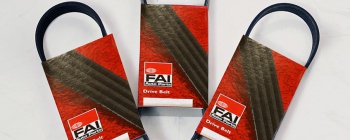
FAI’s Michael Dieckmann explains the difference between regular and stretch belts and gives some hints and tips.
Stretch belts were introduced as OE fit by some vehicle manufactures around a decade ago and although prevalent in the aftermarket, they are still less common than traditional Poly V belts.
If you are less familiar with the concept and practice of the stretch belt, the following information may help to take some of the mystery away from when and why stretch belts should be used.
No tensioner required

Stretch belts do not require a separate belt tensioner as they tension themselves automatically over their complete service life. Not needing a tensioner reduces costs and complexity and saves weight and space for the engine designer.
The most important thing to remember is that you must replace belts like for like with the OE fitment. If a vehicle is fitted with a stretch belt from new, it must have a stretch belt replacement fitted.
Stretch belts will have been specified for auxiliary and accessory drives, typically alternators, fan, water pump, air conditioner compressor and power steering systems. They are reliant on applications that have fixed-centre distances and are suitable for lower and mid output ranges.
High-Tech manufacturing material
FAI stretch belts are made from EPDM Elastomer, an incredibly strong, flexible and stretchable material that offers very long service, together with low noise and prolonged bearing life. Because they are designed to stretch, they are not interchangeable with ordinary Poly V belts, as they are slightly shorter in length.
Fitting an FAI Stretch Belt
Successful fitting of an FAI stretch belt requires an appropriate special tool. You must never improvise a tool, such as using a screwdriver or pry bar as the belt can be easily damaged, leading to premature failure.
Never force the belt into position and before fitting, check the condition of all belt pulleys. They should not be dirty, rusty, have any sharp edges or other damage. Either properly clean any such pulleys or replace them. However, cleaning should never be carried out with harsh solvents as this can badly damage plastic components and lead to belt damage and ultimate failure.
Finally, check that the pulley type is a match for the profile of the stretch belt and that pulleys are accurately aligned before fitting. The belt must run true and straight, not at an angle.
New to FAI Range!

The FAI Stretch Belt range is always stretching itself to bring new and popular fast-moving applications to market. In fact, FAI has recently introduced a further 8 part numbers, covering 172 applications, of its popular stretch belt range.
There are now over 300 applications available from our range, many of which have been added since the release of our 2013 belting catalogue. Full details can be seen at www.faiauto.com, or call the FAI Customer Services line at 0708 391802


 Click here to open the navigation menu
Click here to open the navigation menu